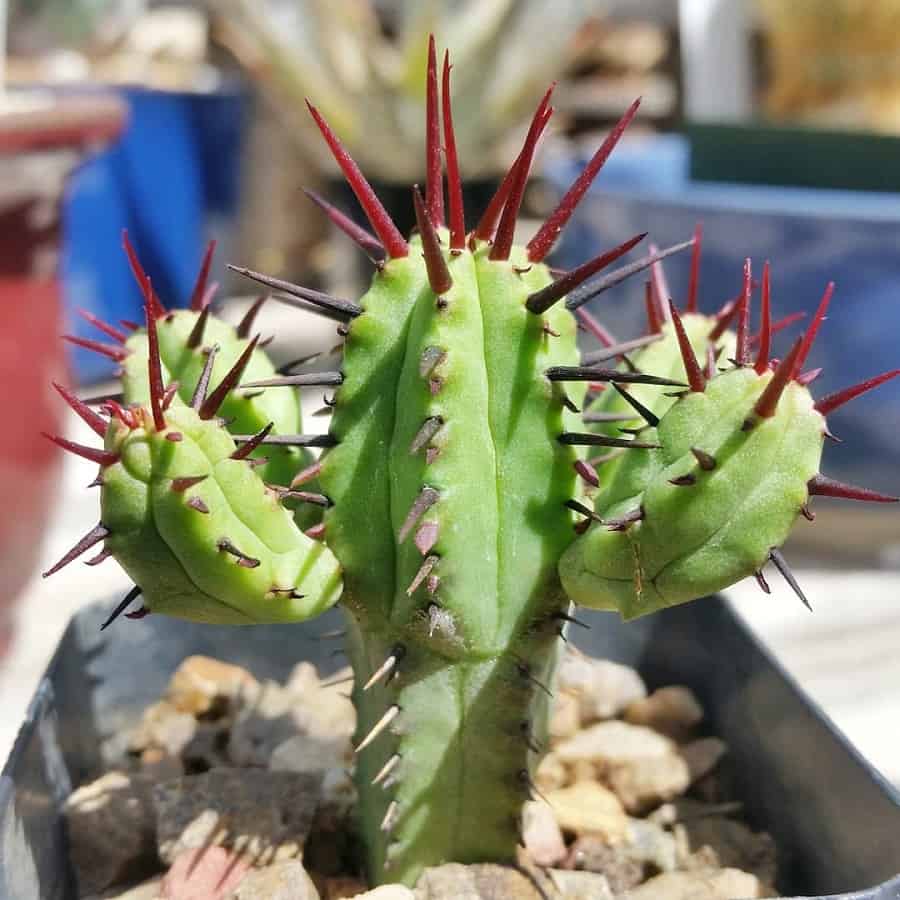Bored with Your Garden? Euphorbia enopla Will Blow Your Mind!
Are you tired of the same old plants in your yard? Spice things up with the mind-blowing Euphorbia enopla! This quirky succulent, also known as the pincushion plant, is guaranteed to be the star of your garden. With its funky spiky stems and vibrant flowers, it’s a showstopper you won’t want to miss. Keep reading to unlock the secrets to easily growing this captivating plant!

Contents
About Euphorbia enopla
The Euphorbia enopla is a striking multi-branched succulent that grows as a shrub. Its thick green stems can reach up to 1 inch in diameter while sometimes appearing grayish or bluish. The real head-turners are the reddish-pink spines protruding all around the stems, each about 1 inch tall. While leaves may sprout, they typically wither away quickly. Male flowers bloom in yellow while females flaunt a vibrant red hue.
Related Post:
200 Types of Euphorbia With Pictures
Euphorbia enopla Care Guide
Light Requirements
Euphorbia enopla thrives in full sun, needing at least 6 hours of direct sunlight daily. In regions with intense afternoon sun, provide some protection to prevent burns or yellowing. Grow lights can replicate sunlight if growing indoors – place the plant 6-12 inches away and keep lights on for 12-16 hours per day.
Watering
From spring to fall, allow the top 2 inches of soil to dry out before watering thoroughly. This equates to roughly once a week, as Euphorbia enopla originates from semi-arid rocky regions with excellent drought tolerance. In winter dormancy, only water if the plant begins shriveling. Morning is ideal for watering to prep the plant for daily sun exposure.
Soil

Euphorbia enopla is a succulent, so it requires well-draining soil to prevent rot. Make your own gritty mix by combining 1 part potting soil, 1 part coarse sand, and 1 part perlite or pumice. Alternatively, use a commercially available cactus/succulent potting mix straight out of the bag.
Fertilizer
Apply a balanced cactus/succulent fertilizer in spring and summer while actively growing. Use a liquid fertilizer diluted to 1⁄4 or 1⁄2 strength. Container plants require more frequent feeding every 4-6 weeks. Stop fertilizing in fall and winter when growth is minimal. Yellow leaves indicate a need for fertilizer.
Climate
Euphorbia enopla prefers average to warm temperatures between 70-80°F during the day and 55-65°F at night. Provide at least 50% humidity year-round. It can tolerate dry indoor conditions but does best with moderate humidity levels.
Potting and Repotting
Choose a terracotta or glazed ceramic pot with a drainage hole to allow excess moisture to escape. Pots that are too large will hold moisture too long. For most mature plants, a 6-8 inch diameter pot is ideal.
Repot annually in early spring before the growing season. Gently remove the old soil from the root ball and plant in fresh gritty succulent soil. Choose a new pot only 1-2 inches wider than the previous to avoid excess soil staying wet. Burying the plant deeper than it was before can lead to rot.
Pruning
Prune away any dead, damaged or overly leggy stems in early spring before new growth emerges. Use clean pruners and cut stems back to just above a leaf node to promote branching.
Pests and Diseases
Spider mites and mealybugs are the biggest pest problems. Inspect plants regularly and treat infestations early with insecticidal soap or neem oil. Good air circulation, proper watering, and quarantining new plants help prevent diseases.

Propagating Euphorbia enopla
Euphorbia enopla can be propagated from stem cuttings or seeds for an endless supply of new plants!
Stem Cuttings
- Use a sterile knife or pruners to cut a 4-6 inch stem piece from the plant.
- Allow the cutting to callus over for 2-3 days before continuing.
- Fill a pot with cactus/succulent soil and push the cutting 2 inches into the mix.
- Water sparingly every 1-2 weeks until new growth appears in 4-8 weeks.
Seeds
Though slower, propagating from seed produces unique variations!
- Fill a tray with an equal mix of coarse sand and seed-starter mix.
- Press seeds 1⁄4 inch into the soil, spacing 2 inches apart.
- Keep soil lightly moist and be patient – germination may take 2-6 months.
